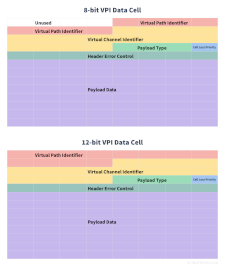VPI
Stands for "Virtual Path Identifier."
A VPI is an 8- to 12-bit header in an Asynchronous Transfer Mode (ATM) cell that identifies the path the cell should take to its destination. An ATM cell's VPI works in conjunction with its Virtual Channel Identifier (VCI) to guide a cell as it passes through multiple ATM switches. The size of a VPI depends on the size and scale of the ATM network; small networks use an 8-bit VPI that supports hundreds of paths, while large networks use a 12-bit VPI that supports several thousand unique paths.
ATM is a networking technology that creates virtual paths for data cells to travel across to their destination. Unlike IP routing, where a packet in a data stream can take one of many possible routes, ATM cells in a data stream all take the same route. The VPI information in each cell's header identifies the specific virtual path the cell should take.
While ATM was designed to be more efficient at routing network traffic, in practice ATM networks were quite complex. The small size of each data cell, combined with the data taken up by VPI and VCI headers, resulted in significant overhead. Ethernet and IP-based networking technologies were simpler and scaled better to high traffic, eventually taking over the role that ATM networking had filled.
 Test Your Knowledge
Test Your Knowledge